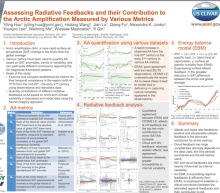Quantifying Arctic Amplification and the Contribution of Radiative Feedbacks with Various Metrics
Yiling
Huo
Atmospheric, Climate, and Earth Sciences Division, Pacific Northwest National Laboratory, Richland, WA, USA
Poster
Arctic amplification (AA), characterized by a more rapid surface air temperature (SAT) change in the Arctic than the global average, is a major feature of both contemporary and historical global climate change. Various metrics have been used to quantify AA based on SAT anomalies, trends, or variability, and they can yield quite different conclusions regarding the magnitude and temporal patterns of AA. In this study, we compare several established AA metrics for their consistency in temporal signatures in the region north of 70°N from the mid-20th century to the early 21st century using observational data and reanalysis products. We also quantify contributions of different radiative feedback mechanisms to AA based on short-term climate variability in reanalysis and model data using the Kernel-Gregory approach. Albedo and lapse rate feedbacks are positive and comparable, with albedo feedback being the dominant contributor for all AA metrics. The net cloud feedback has large uncertainties, which strongly depends on the data used, the time periods considered, and the metrics used to quantify AA. Utilizing global climate model ensemble simulations, the influence of internal variability on AA and feedback analysis is also quantified. Water vapor and cloud feedbacks are found to be most heavily influenced by internal variability. A moist static energy balance model (EBM), incorporating regional feedbacks and diffusivity from reanalysis products, is further employed to establish a robust connection between the estimated regional feedbacks and their contribution to both remote and regional surface warming, including the polar amplified warming. The EBM can be used to investigate how feedback pattern uncertainties drive variabilities in SAT response. Our analysis of feedback contributions to AA provides a quantitative measure of the sensitivity of feedbacks in the Arctic climate system to the choice of different AA metrics.

yiling-huo-polar-poster.pdf
(3.37 MB)
